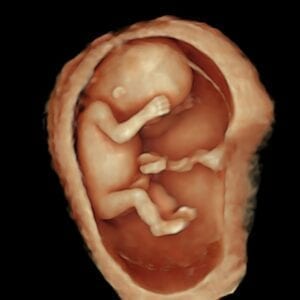NIPT (Non-invasive Prenatal Testing) is an optional blood test that can be performed in the first trimester from 10 weeks of pregnancy and is used to screen for some genetic conditions. Read more about NIPT:
How does NIPT work?
At City Ultrasound, we offer the Harmony Test, which is an extensively clinically validated type of NIPT. The Harmony Test is able to sensitively screen for:
- Down Syndrome (Trisomy 21),
- Trisomy 18,
- Trisomy 13,
- Fetal Sexing.
How does NIPT work?
Most of our genetic material (DNA) is contained within our cells; however, a small proportion of this circulates in our blood as cell-free DNA (cfDNA). When a woman is pregnant, the blood also contains cell-free DNA fragments from the placenta, which has a genetic make-up practically identical to that of the developing baby.
By taking a simple blood sample, the laboratory can isolate the cell-free DNA fragments and screen for risks associated with certain genetic conditions.
What can NIPT show me about my pregnancy?
At present, NIPT is an extremely sensitive test for Down’s Syndrome and it performs significantly better than the Combined Screening Test used by the NHS. However, it is important to understand that NIPT is a screening test—this means that it cannot give you a definitive diagnosis or 100% exclude any of the genetic conditions. Its purpose is to estimate whether the baby has an increased or decreased chance of the genetic conditions being tested for.
What are the limitations of NIPT?
As a screening test, NIPT can give an indication of your chance for these genetic conditions, but it cannot be used as a diagnostic tool—further tests would be needed for this. There are also instances where the test gives false-positive or false-negative results, which can give you a false sense of worry or security.
We, at City Ultrasound, strongly believe that the optimal method for checking the health of your baby during the first trimester includes the NIPT and ultrasound scanning (conducted by a specialist). More specifically, we believe that the combination of the Early Fetal Scan and NIPT is the ideal screening option. Of course, no screening program is 100% definitive, but this option allows for a detailed examination of the baby’s physical anatomy, such as the structure of the heart and brain (from the ultrasound), NIPT (as discussed above), as well as the assessment of Nuchal Translucency (NT), which examines the pocked of fluid behind the baby’s neck, giving us more information about the chances of different anomalies. This way we can offer the most information regarding all aspects of your baby’s health.
What’s next?
Normally, a “low chance” result from NIPT is very reassuring, as the test has a high negative predictive value (greater than 99%) for Down’s Syndrome.
As NIPT is not diagnostic, if a result was to suggest and increased chance of chromosomal anomaly, there would be an option to perform CVS (placental biopsy) or amniocentesis. While those are invasive and carry a small risk (0.5-1%) of miscarriage, these tests can give definitive results about the chromosomal abnormalities that may be present. Invasive tests are performed in specialist Fetal Medicine Units of hospitals. The decision to perform the invasive test is something that should be discussed with your healthcare team.
Read more here
Book your NIPT here

 Estimate the Gestational Age (GA) or the Estimated Due Date (EDD)
Estimate the Gestational Age (GA) or the Estimated Due Date (EDD) Twins in a womb at about 8 weeks GA via a standard 2D transabdominal scan. Note that both embryos are about the size of a blueberry at this stage!
Twins in a womb at about 8 weeks GA via a standard 2D transabdominal scan. Note that both embryos are about the size of a blueberry at this stage! A transvaginal (TVS) 3D image of twins in the womb at about 9 weeks GA
A transvaginal (TVS) 3D image of twins in the womb at about 9 weeks GA A model we have at the clinic to demonstrate the development of twins in the womb at later stages in the pregnancy.
A model we have at the clinic to demonstrate the development of twins in the womb at later stages in the pregnancy.



